Showing Spotlights 425 - 432 of 547 in category All (newest first):
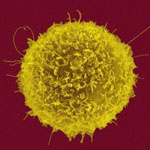 Scientists consider the exploration of carbon nanotubes (CNTs) for biomedical applications as a field with significant potential, leading to applications where CNTs could act as magnetic nano-heaters, drug-carrier systems and sensors which allow a diagnostic and therapeutic usage on a cellular level. The EU, for instance, has funded a four-year nanotechnology research program that studies the chemical and physical properties of CNTs in order to find mechanisms which can be applied for a biomedical purpose in appropriate medical devices. Studies of their interaction with biological environments (immune response, toxicity, interaction with the single cell) will provide the basis for applying the CNT for imaging (nanoparticles-based contrast agents), sensoring (nanoparticles-based diagnostics) and cancer treatment (hyperthermia, nanotechnology-based targeted drug delivery). A new study that exploits the unique properties of single-walled CNTs (SWCNT) for biomedical purposes shows the use of SWCNTs as an efficient platform for immunotherapeutic applications. Scientists demonstrate the surface area tunability of SWCNT bundles by chemical treatment and its effect on antibody adsorption and subsequent T cell activation. T cells are central players in initiating and maintaining immune responses. An important goal of successful immunotherapy is the stimulation of T cell immune responses against targets of interest such as tumors.
Scientists consider the exploration of carbon nanotubes (CNTs) for biomedical applications as a field with significant potential, leading to applications where CNTs could act as magnetic nano-heaters, drug-carrier systems and sensors which allow a diagnostic and therapeutic usage on a cellular level. The EU, for instance, has funded a four-year nanotechnology research program that studies the chemical and physical properties of CNTs in order to find mechanisms which can be applied for a biomedical purpose in appropriate medical devices. Studies of their interaction with biological environments (immune response, toxicity, interaction with the single cell) will provide the basis for applying the CNT for imaging (nanoparticles-based contrast agents), sensoring (nanoparticles-based diagnostics) and cancer treatment (hyperthermia, nanotechnology-based targeted drug delivery). A new study that exploits the unique properties of single-walled CNTs (SWCNT) for biomedical purposes shows the use of SWCNTs as an efficient platform for immunotherapeutic applications. Scientists demonstrate the surface area tunability of SWCNT bundles by chemical treatment and its effect on antibody adsorption and subsequent T cell activation. T cells are central players in initiating and maintaining immune responses. An important goal of successful immunotherapy is the stimulation of T cell immune responses against targets of interest such as tumors.
Jul 10th, 2008
 Cells are the basic building blocks of life. The ability to sense and modify intracellular processes is important for, among other things, bettering our understanding of biological processes, developing drugs and evaluating their effectiveness, and modifying cell function. Due to the cell's small size and fragility, probing the cell's interior with high precision is not a simple task. To address this challenge, researchers have developed nanoscale, carbon-based cellular probes ('carbon nanopipettes' or CNP). The CNP consists of a glass capillary lined with a carbon film along its inner surface and terminating with an exposed carbon nanopipe. The probes are fabricated through a process that does not require any assembly and that facilitates quantity fabrication. Depending on controllable process conditions, the carbon tip's diameter may vary from tens to hundreds of nanometers and its length can range from zero to a few micrometers.
Cells are the basic building blocks of life. The ability to sense and modify intracellular processes is important for, among other things, bettering our understanding of biological processes, developing drugs and evaluating their effectiveness, and modifying cell function. Due to the cell's small size and fragility, probing the cell's interior with high precision is not a simple task. To address this challenge, researchers have developed nanoscale, carbon-based cellular probes ('carbon nanopipettes' or CNP). The CNP consists of a glass capillary lined with a carbon film along its inner surface and terminating with an exposed carbon nanopipe. The probes are fabricated through a process that does not require any assembly and that facilitates quantity fabrication. Depending on controllable process conditions, the carbon tip's diameter may vary from tens to hundreds of nanometers and its length can range from zero to a few micrometers.
Jul 8th, 2008
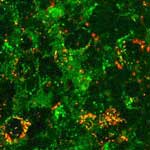 The challenge in treating most brain disorders is overcoming the difficulty of delivering therapeutic agents to specific regions of the brain by crossing the blood-brain barrier (BBB). This barrier - a tight seal of endothelial cells that lines the blood vessels in the brain - is a physiological checkpoint that selectively allows the entry of certain molecules from blood circulation into the brain. The problem for scientists is that the BBB does not differentiate what it keeps out. BBB strictly limits transport into the brain through both physical (tight junctions) and metabolic (enzymes) barriers. With very few exceptions, only nonionic and low molecular weight molecules soluble in fat clear the BBB. For instance, alcohol, caffeine, nicotine and antidepressants meet these criteria. However, large molecules needed to deliver drugs do not. The utter scarcity of techniques for brain-specific delivery of therapeutic molecules using non-invasive approaches (like drilling a hole in the skull) has led researchers to increasingly explore the vast potential of nanotechnology toward the diagnosis and treatment of diseases/disorders incurable with present techniques.
The challenge in treating most brain disorders is overcoming the difficulty of delivering therapeutic agents to specific regions of the brain by crossing the blood-brain barrier (BBB). This barrier - a tight seal of endothelial cells that lines the blood vessels in the brain - is a physiological checkpoint that selectively allows the entry of certain molecules from blood circulation into the brain. The problem for scientists is that the BBB does not differentiate what it keeps out. BBB strictly limits transport into the brain through both physical (tight junctions) and metabolic (enzymes) barriers. With very few exceptions, only nonionic and low molecular weight molecules soluble in fat clear the BBB. For instance, alcohol, caffeine, nicotine and antidepressants meet these criteria. However, large molecules needed to deliver drugs do not. The utter scarcity of techniques for brain-specific delivery of therapeutic molecules using non-invasive approaches (like drilling a hole in the skull) has led researchers to increasingly explore the vast potential of nanotechnology toward the diagnosis and treatment of diseases/disorders incurable with present techniques.
Jul 3rd, 2008
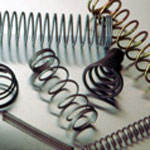 Elastomeric (i.e. elastic) proteins are able to withstand significant deformations without rupture before returning to their original state when the stress is removed. Consequently, these proteins confer excellent mechanical properties to many biological tissues and biomaterials. Depending on the role performed by the tissue or biomaterial, elastomeric proteins can behave either as springs or shock absorbers. Recent scientific work in Canada resulted in the engineering of the first artificial chameleon elastomeric proteins that mimic and combine these two different behaviors into one protein. Under the regulation of a molecular regulator, these designer proteins exhibit one of the two distinct mechanical behaviors - spring or shock absorber - which closely mimic the two extreme behaviors observed in naturally occurring elastomeric proteins.
Elastomeric (i.e. elastic) proteins are able to withstand significant deformations without rupture before returning to their original state when the stress is removed. Consequently, these proteins confer excellent mechanical properties to many biological tissues and biomaterials. Depending on the role performed by the tissue or biomaterial, elastomeric proteins can behave either as springs or shock absorbers. Recent scientific work in Canada resulted in the engineering of the first artificial chameleon elastomeric proteins that mimic and combine these two different behaviors into one protein. Under the regulation of a molecular regulator, these designer proteins exhibit one of the two distinct mechanical behaviors - spring or shock absorber - which closely mimic the two extreme behaviors observed in naturally occurring elastomeric proteins.
Jul 2nd, 2008
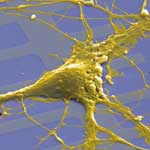 Bionics - a word formed from biology and electronics - has become a quickly expanding research field, exploring ways and materials to bridge the interface between electronics and biology. Basically, there are three levels of biocommunications where electronics and biology could interface: molecular, cellular and skeletal. For any implanted bionic material it is the initial interactions at the biomolecular level that will determine longer term performance. While bionics is often associated with skeletal level enhancements, electronic communication with living cells is of interest with a view to improving the results of tissue engineering or the performance of implants such as bionic ears or eyes. Researchers have worked for more than 20 years on interfacing neurons and silicon devices. Analysis of the electro-physiological activity of neurons could one day enable scientists to develop artificial prostheses for bypassing injured zones and restore brain functionality, or to realize neuro-diagnostic tools for monitoring the reaction of biological neurons to selected chemical species or newly developed drugs. Making another step in this direction, researchers in Europe have now demonstrated the possibility of integrating living neural cells and organic semiconductor thin-films made of a few monolayers of pentacene.
Bionics - a word formed from biology and electronics - has become a quickly expanding research field, exploring ways and materials to bridge the interface between electronics and biology. Basically, there are three levels of biocommunications where electronics and biology could interface: molecular, cellular and skeletal. For any implanted bionic material it is the initial interactions at the biomolecular level that will determine longer term performance. While bionics is often associated with skeletal level enhancements, electronic communication with living cells is of interest with a view to improving the results of tissue engineering or the performance of implants such as bionic ears or eyes. Researchers have worked for more than 20 years on interfacing neurons and silicon devices. Analysis of the electro-physiological activity of neurons could one day enable scientists to develop artificial prostheses for bypassing injured zones and restore brain functionality, or to realize neuro-diagnostic tools for monitoring the reaction of biological neurons to selected chemical species or newly developed drugs. Making another step in this direction, researchers in Europe have now demonstrated the possibility of integrating living neural cells and organic semiconductor thin-films made of a few monolayers of pentacene.
Jun 30th, 2008
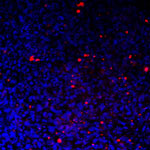 Regenerative medicine is an area in which stem cells hold great promise for overcoming the challenge of limited cell sources for tissue repair. Stem cell research is being pursued in laboratories all over the world in the hope of achieving major medical breakthroughs. Scientists are striving to create therapies that rebuild or replace damaged cells with tissues grown from stem cells and offer hope to people suffering from cancer, diabetes, cardiovascular disease, spinal-cord injuries, and many other disorders. Embryonic stem cells are pluripotent. That means that during normal embryogenesis human embryonic stem cells (hESCs) can differentiate into any of the more than 220 cell types in the adult body. Researchers have now developed a new methodology to enhance the vascular differentiation of hESCs by incorporating growth factor-releasing micro- and nanoparticles in embryoid bodies.
Regenerative medicine is an area in which stem cells hold great promise for overcoming the challenge of limited cell sources for tissue repair. Stem cell research is being pursued in laboratories all over the world in the hope of achieving major medical breakthroughs. Scientists are striving to create therapies that rebuild or replace damaged cells with tissues grown from stem cells and offer hope to people suffering from cancer, diabetes, cardiovascular disease, spinal-cord injuries, and many other disorders. Embryonic stem cells are pluripotent. That means that during normal embryogenesis human embryonic stem cells (hESCs) can differentiate into any of the more than 220 cell types in the adult body. Researchers have now developed a new methodology to enhance the vascular differentiation of hESCs by incorporating growth factor-releasing micro- and nanoparticles in embryoid bodies.
Jun 24th, 2008
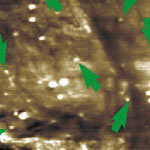 Nanomaterial-based drug-delivery and nanotoxicology are two of the areas that require sophisticated methods and techniques for characterizing, testing and imaging nanoparticulate matter inside the body. Especially the potential risk factors of certain nanomaterials have become a heated topic of discussion recently. Most, if not all, toxicological studies on nanoparticles rely on current methods, practices and terminology as gained and applied in the analysis of micro- and ultrafine particles and mineral fibers. The development of novel imaging techniques that can visualize local populations of nanoparticles at nanometer resolution within the structures of cells - without destroying or damaging the cell - are therefore important. Researchers in the U.S. have now demonstrated that at ultrasonic frequencies, intracellular nanomaterial cause sufficient wave scattering that a probe outside the cell can respond to. This ultrasonic holography technique provides a non-invasive way of looking inside a cell.
Nanomaterial-based drug-delivery and nanotoxicology are two of the areas that require sophisticated methods and techniques for characterizing, testing and imaging nanoparticulate matter inside the body. Especially the potential risk factors of certain nanomaterials have become a heated topic of discussion recently. Most, if not all, toxicological studies on nanoparticles rely on current methods, practices and terminology as gained and applied in the analysis of micro- and ultrafine particles and mineral fibers. The development of novel imaging techniques that can visualize local populations of nanoparticles at nanometer resolution within the structures of cells - without destroying or damaging the cell - are therefore important. Researchers in the U.S. have now demonstrated that at ultrasonic frequencies, intracellular nanomaterial cause sufficient wave scattering that a probe outside the cell can respond to. This ultrasonic holography technique provides a non-invasive way of looking inside a cell.
Jun 23rd, 2008
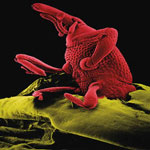 The demand for antimicrobial coatings is growing at a fast pace. In the U.S. alone, the market for these products is expected to grow from $175 million in 2005 to over $550 million in 2012. This market is not only driven by the urgent need of hospitals to reduce infections, although it would appear that they need it most: the U.S. Centers for Disease Control and Prevention (CDC) estimates that the infections acquired in hospitals alone affect approximately 2 million persons annually. In the U.S., between 44,000 and 98,000 people die every year from infections they picked up in hospitals. With a growing concern about the role of contaminated surfaces in the spread of infections such as SARS and MRSA, antimicrobial surfaces have become popular in such areas as consumer products, public spaces such as schools and offices, and public transportation. While many conventional antibacterial coatings release their antimicrobials over time (either controlled or uncontrolled) and thereby lose their antimicrobial efficiency, researchers have now developed a unique multifunctional biomimetic material comprised of carbon nanotubes, DNA, and lysozyme that has robust mechanical properties and exhibits excellent long-term antimicrobial activity.
The demand for antimicrobial coatings is growing at a fast pace. In the U.S. alone, the market for these products is expected to grow from $175 million in 2005 to over $550 million in 2012. This market is not only driven by the urgent need of hospitals to reduce infections, although it would appear that they need it most: the U.S. Centers for Disease Control and Prevention (CDC) estimates that the infections acquired in hospitals alone affect approximately 2 million persons annually. In the U.S., between 44,000 and 98,000 people die every year from infections they picked up in hospitals. With a growing concern about the role of contaminated surfaces in the spread of infections such as SARS and MRSA, antimicrobial surfaces have become popular in such areas as consumer products, public spaces such as schools and offices, and public transportation. While many conventional antibacterial coatings release their antimicrobials over time (either controlled or uncontrolled) and thereby lose their antimicrobial efficiency, researchers have now developed a unique multifunctional biomimetic material comprised of carbon nanotubes, DNA, and lysozyme that has robust mechanical properties and exhibits excellent long-term antimicrobial activity.
Jun 10th, 2008
 Scientists consider the exploration of carbon nanotubes (CNTs) for biomedical applications as a field with significant potential, leading to applications where CNTs could act as magnetic nano-heaters, drug-carrier systems and sensors which allow a diagnostic and therapeutic usage on a cellular level. The EU, for instance, has funded a four-year nanotechnology research program that studies the chemical and physical properties of CNTs in order to find mechanisms which can be applied for a biomedical purpose in appropriate medical devices. Studies of their interaction with biological environments (immune response, toxicity, interaction with the single cell) will provide the basis for applying the CNT for imaging (nanoparticles-based contrast agents), sensoring (nanoparticles-based diagnostics) and cancer treatment (hyperthermia, nanotechnology-based targeted drug delivery). A new study that exploits the unique properties of single-walled CNTs (SWCNT) for biomedical purposes shows the use of SWCNTs as an efficient platform for immunotherapeutic applications. Scientists demonstrate the surface area tunability of SWCNT bundles by chemical treatment and its effect on antibody adsorption and subsequent T cell activation. T cells are central players in initiating and maintaining immune responses. An important goal of successful immunotherapy is the stimulation of T cell immune responses against targets of interest such as tumors.
Scientists consider the exploration of carbon nanotubes (CNTs) for biomedical applications as a field with significant potential, leading to applications where CNTs could act as magnetic nano-heaters, drug-carrier systems and sensors which allow a diagnostic and therapeutic usage on a cellular level. The EU, for instance, has funded a four-year nanotechnology research program that studies the chemical and physical properties of CNTs in order to find mechanisms which can be applied for a biomedical purpose in appropriate medical devices. Studies of their interaction with biological environments (immune response, toxicity, interaction with the single cell) will provide the basis for applying the CNT for imaging (nanoparticles-based contrast agents), sensoring (nanoparticles-based diagnostics) and cancer treatment (hyperthermia, nanotechnology-based targeted drug delivery). A new study that exploits the unique properties of single-walled CNTs (SWCNT) for biomedical purposes shows the use of SWCNTs as an efficient platform for immunotherapeutic applications. Scientists demonstrate the surface area tunability of SWCNT bundles by chemical treatment and its effect on antibody adsorption and subsequent T cell activation. T cells are central players in initiating and maintaining immune responses. An important goal of successful immunotherapy is the stimulation of T cell immune responses against targets of interest such as tumors.
 Subscribe to our Nanotechnology Spotlight feed
Subscribe to our Nanotechnology Spotlight feed





